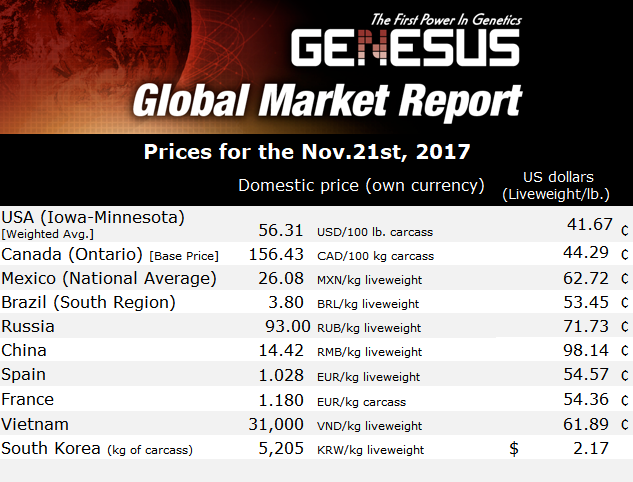
Market Report South East Asia
Paul Anderson – General Manager South East Asia and International Sales Manager
Thailand
After the live weight pig price hitting rock bottom in October 2017, the pig price in Thailand is recovering in November and is expected to get better in December as the New Year party is approaching.
October was a bad time for pig farmers in Thailand. Heavy rains and floods were forcing them to sell pigs and sows in rush to avoid losses as they were at risk from inundation.
Couple this with the vegetarian festival during the month, consumption of pork was dropping significantly. The ex-farm price of live pigs in the country plunged to THB 45/kg (USD 1.3), well below the cost of production estimated at THB 55/kg (USD 1.6).
Slow consumption was exacerbated by rising retail prices or pork. Vendors in wet markets declined to lower the price, even though they bought live pigs from farmers at a very cheap price. The retail price of pork loin jumped more than threefold to THB 150/kg (USD 2.6).
In response, the farmers were united to raise the price. They also collaborated with some vendors to sell pork at a more reasonable price.
This effort was slowly pulling up the pig price in November, nearly on par with the production cost at THB 55/kg (USD 1.6) in the third week of the month.
There is an increased Interest in welfare, large producers in Thailand announced that they have adopted an animal welfare approach in rearing pigs. The move is made in response to growing concerns over animal welfare by the consumers.
In doing so, dry sow stalls and farrowing crates are removed. It was reported that this practice not only improves welfare conditions for the pigs, but also contributes to a better reproductive performance of sows, I think most European farmers that have had the dry sow stall ban imposed on them would beg to differ, I believe most producers would claim a reduction in sow performance following the introduction of group housing especially from weaning and through the mating and implantation period.
This is motivating other Thai producers to adopt the welfare approach in their operations. Apart from improved welfare and reproductive performance, investment in faculty for raising dry sows in group and crate-free farrowing is also cheaper than the conventional system.
The success, however, will be based on the sow behaviour too. With a greater freedom, the sows need to be more docile and less aggressive, Genesus genetics have the strong legs and calm temperament necessary for these group and freedom swine production systems. Our genetic technicians always make sure that feet and legs are thoroughly screened at selection. Longevity of sows in production is critical to return on your genetic investment. Genesus commercial herds routinely achieve the goal of weaning over 60 pigs per gilt entered, with some reaching as high as 80, I guess this is the reason why Genesus is growing its market share in this market.
Vietnam
The price of the live-weight slaughter pig in Vietnam is still below the cost of production for most producers the current pig price is around 30.000 – 31.000 VND/kg live weight (USD 1.35).
As the number of pig breeding households continues to drop, a shortage of live pigs could result in high pork prices later this year or early into the new year, the ministry estimates that pig herd numbers have declined by 10 per cent year on year as of September this year. Pork production in the third quarter was 522,000 tonnes, down 2.3 per cent compared with the previous year.
The situation has resulted out of a long-term plunge in pork prices. The foot-and-mouth disease outbreak in a number of northern provinces was also a reason for many smaller and back yard farmers deciding to stop breeding pigs.
According to the MARD’s Department of Livestock Production, the smaller pig farmers are also not interested in expanding their pig due to unstable pork prices. The department estimates that the number of pig breeding households is predicted to reduce by a third, or between 800,000 and 900,000 by the end of this year.
About 40 per cent of small scale pig breeders, amounting to tens of thousands of households, have gone bankrupt. This has created difficulties for local authorities in generating employment and in ensuring social security and order.
Several pig producers have turned to exports because of low consumption and prices in the domestic market.
The government is now actively controlling the expansion of new sow farm’s. There are plans to establish disease-free zones to reduce production costs and facilitate pork export to markets like Europe. The focus of the government is to encourage and support the forward-thinking companies to set up a supply chain from farm through to the retail outlet., build modern slaughter and meat processing plants and a strong focus on meat hygiene and food safety.
The top ten provinces for the high pig population is Dong Nai (1.75 million), Ha Noi (1.6), Bac Giang (1.3), Thai Binh (1.1), Thanh Hoa (0.9), Nghe An (0.9), Phu Tho (0.9), Dac Lac (0.8), Binh Dinh (0.8) and Nam Dinh (0.8).
Malaysia
Please to hear from Mr Lim Boon Wee how well the Genesus Landrace have settled into his farm, improving the number born, quality of piglet and reducing the days to slaughter just to name a few of the improvements.
Categorised in: Featured News, Global Markets
This post was written by Genesus



